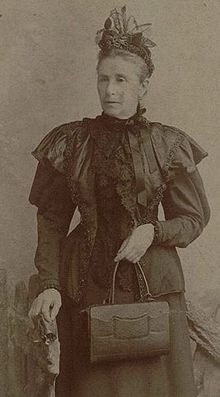Amalia Freud
Amalia Freud | |
|---|---|
 Freud in 1903 | |
| Born | Amalia Malka Nathansohn 18 August 1835 Brody, Kingdom of Galicia and Lodomeria (present-day Ukraine) |
| Died | 12 September 1930 (aged 95) |
| Known for | Being the mother of Sigmund Freud |
| Spouse | Jacob Freud |
| Children | 8, including Sigmund Freud |
| Relatives | Ernst L. Freud (grandson) Anna Freud (granddaughter) |
Amalia Malka Nathansohn Freud (née Nathansohn; 18 August 1835 – 12 September 1930) was the mother of Sigmund Freud. She was born in Brody, Kingdom of Galicia and Lodomeria[1] to Jacob Nathanson and Sarah Wilenz and later grew up in Odesa, where her mother came from (both cities located in modern-day Ukraine). She was married to Jacob Freud.
Amalia Freud died in Vienna at the age of 95 of tuberculosis.
Children
[edit]On 6 May 1856, when Amalia Freud was 20 years old, she gave birth to her first child, Sigmund Schlomo,[2] a famous neurologist and the founder of psychoanalysis.
Including Sigmund, she had 8 children with her husband Jacob Freud; however, her other children are not as renowned as their elder brother. They are enumerated below in the consecutive order of birth.
- Julius (born in April 1857, died in December that year)
- Anna (born on 31 December 1858,[3] died on 11 March 1955)
- Regine Debora (Rosa) (born on 21 March 1860, deported to Treblinka on 23 September 1942)
- Marie (Mitzi) (born on 22 March 1861, deported to Treblinka 23 September 1942)
- Esther Adolfine (Dolfi) (born on 23 July 1862 – died on 5 February 1943 in Theresienstadt)
- Pauline Regine (Pauli) (born on 3 May 1864, deported to Treblinka on 23 September 1942)
- Alexander Gotthold Efraim (born on 19 April 1866, died on 23 April 1943)[4]
Character
[edit]Amalia was considered by her grandchildren to be an intelligent, strong-willed, quick-tempered but egotistical personality.[5] Ernest Jones saw her as lively and humorous, with a strong attachment to her eldest son whom she called "mein goldener Sigi".[6]
Relationship with eldest son
[edit]
Just as Amalia idolised her eldest son, so there is evidence that the latter in turn idealised his mother, whose domineering hold over his life he never fully analysed.[7] He did however recount a railway journey with her at the age of 4 amongst his earliest memories and also recalled her instruction in German reading and writing.[8] Late in life he would term the mother-son relationship "the most perfect, the most free from ambivalence of all human relationships. A mother can transfer to her son the ambition she has been obliged to suppress in herself".[9] His tendency to split off and repudiate hostile elements in the relationship would be repeated with significant figures in his life such as his fiancée and Wilhelm Fliess.[10]
See also
[edit]References
[edit]- ^ "Sigmund Freud's Birth Record ("Amalia, daughter of Jakob Nathanson and Sara née Wilenz")". digi.archives.cz. Retrieved 18 July 2021.
- ^ http://www.pep-web.org/document.php?id=MPSA.014.0037A
- ^ "Anna Freud's Birth Record". digi.archives.cz. Retrieved 3 February 2022.
- ^ "Answers - the Most Trusted Place for Answering Life's Questions". Answers.com.
- ^ Peter Gay, Freud (1989) p. 504
- ^ Ernest Jones, The Life and Work of Sigmund Freud (1964) p. 32-3
- ^ Peter Gay, Freud (1989) p. 11 and p. 503-5
- ^ De Mijolla, Alain (2005). "Freud-Nathanson, Amalia Malka (1835-1930)". International Dictionary of Psychoanalysis: 629–630.
- ^ Sigmund Freud, New Introductory Lectures on psychoanalysis (1991) p. 168
- ^ Richard Stevens, Sigmund Freud (2008) p. 144-6
